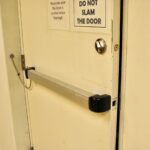 I spend a lot of my time on code development, working with the Builders Hardware Manufacturers Association (BHMA), Codes, Government, and Industry Affairs (CGIA) Committee. Over the last 20+ years, the committee has submitted dozens of code change proposals, with the majority of the proposals being incorporated into the revised codes and standards. One of the BHMA proposals approved for the 2027 edition of the IBC affects locking requirements for schools – you can read about it here.
I spend a lot of my time on code development, working with the Builders Hardware Manufacturers Association (BHMA), Codes, Government, and Industry Affairs (CGIA) Committee. Over the last 20+ years, the committee has submitted dozens of code change proposals, with the majority of the proposals being incorporated into the revised codes and standards. One of the BHMA proposals approved for the 2027 edition of the IBC affects locking requirements for schools – you can read about it here.
Another function of this committee is to monitor proposals submitted by other organizations and individuals, to see how they might impact the requirements for door openings. We offer support, often suggest changes, and sometimes we speak in opposition of a proposal that could negatively affect life safety, fire protection, or accessibility. Because of this attention to all proposals that might be related to the industry, we are aware of potential changes years in advance.
One of the proposals that we’ve been discussing with the proponent, Thom Zaremba, is called G88-25, which would add a new standard – ASTM F3561 – to the International Building Code (IBC) requirements for schools. If you’re not familiar with this standard, it’s the Standard Test Method for Forced-Entry-Resistance of Fenestration Systems After Simulated Active Shooter Attack. G88-25 is an important proposal to follow, and I think we will continue to see a version of it in future code development sessions. You can read the proposal here, and below is a link to an article with more information.
G88-25: When Will We Make Our Schools Safer?
by Thom Zaremba, shareholder at Roetzel & Andress
Excerpt: On May 2 of this year, I presented proposed code change G88-25 to the ICC committee. That proposal would have added a new standard, ASTM F3561, to the IBC. The title of this new standard explains why I proposed adding it to the building code: “Standard Test Method for Forced-Entry-Resistance of Fenestration Systems after Simulated Active Shooter Attack. However, after explaining to the committee that the standard would provide an objective, reproducible, mechanical test to evaluate glass windows, doors and other types of glass entryways into schools for their ability to resist forced entry, the committee unanimously disapproved the proposal. Why?
Click here to read the full article from US Glass.
What are your thoughts on glazing requirements for schools? Feel free to leave a comment!
You need to login or register to bookmark/favorite this content.









Interesting
The proposal actually requires glazing?
I have not been involved in the latest school security plans and building requirements, so I cannot speak if doors should be required glazing?
And not sure how police are set up to get into a locked down school??? I know the Knox box system, but someone needs to know where it is at, and have the key.
Should front entry doors require glazing?? How about just a hardened door? And with all the cameras now days, and the police being able to access them in real time?
Not sure if requiring hardened glazing is the way to go? I could see maybe on exterior doors as an alternative to a hardened no glass door?
Hi Charles –
Most school entrances have glazing and as far as I know this proposal would require the glazing to meet the standard. I don’t think the intent of the proposal is to require glazing, but to strengthen the glazing that is almost always present. Access to the key or electronic credential should be part of the emergency plan.
– Lori